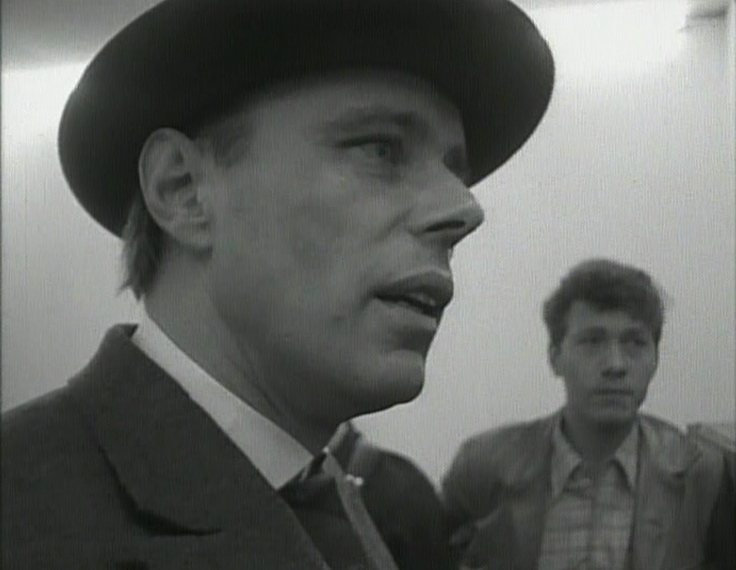DOCUMENTA 4
When Professor Arnold Bode thought up Documenta 1 in 1955, his first job was putting West-Germany, arisen from the ashes, back on the international map. When Documenta 4 takes place in 1968 the international art world is entangled in an authority crisis as well, as Roger Raveel indicates: ”worn threadbare”. At the time Kassel, with Arnold Bode as its artistic director, saw things differently. Documenta 4 was streaked with controversy and debate. The politicization of society in the late 1960s made itself felt in Kassel – red flags and groups of people chanting slogans meant that the opening speeches could not be held. Moreover, Documenta 4 was going through an internal generational conflict and a debate on the fragile relationship of aesthetic judgment and democratic forms of reaching a consensus. In this document Jef Cornelis and interviewer Karel Geirlandt put themselves forward as ’l’homme moyen, monsieur de tout le monde’, who is confronted for the first time with young and still unfamiliar forms of modern art. During interviews with, among others, Sol Lewitt, Joseph Beuys, Harald Szeemann, Allen Jones, Christo, Martial Raysse and Robert Rauschenberg they act the injured innocent and situate themselves on the side of the bewildered spectator. Sublime irony, since things were not that new and innocent at all: the report also contains, for instance, some archive images of Beuys in the Antwerp gallery The Wide White Space.
Content:
00’00" Leader. 00’07" French artists, including Martial Raysse, talking about the place of the artist at Kassel. 00’35" Titles. 00’40" Works by Robert Indiana (Cardinal Numbers), Shusaka Arakawa (Alphabet Skin n° 3) and Getulio Alviani (Interelazione Speculare). 01’35" Construction of Sol LeWitt’s Three Part Variation. 02’20" Joseph Beuys installing his Raumplastik. 02’40" The curator Jan Leering justifying his selections. 03’20" Martial Raysse and other artists criticizing Documenta’s failure to renew itself. Jan Leering’s reactions, alternating with photographs of works by Zdenek Sykora and Christo (Corridor Storefronts). 05’40" Julio Le Parc, Harald Szeemann, Cesar Baldaccini, Pierre Restany and Martial Raysse venting their frustration at Documenta 4. Allen Jones expressing regret at the predominance of American artists. Images of works by Cesar Baldaccini (Duimen). Allen Jones criticizing the lack of space. Jan Leering’s reactions to the preceding criticism. 12’30" Works by Ramon (La faim de I’oeil), Raymond Hains (Allumettes, Seita), Arman (Travaux d’aquarelle) and interview. 16’20" Mike Sonnabend and Weber talking about Documenta. Work by Morris Louis (Greek Garden) and Sol LeWitt. LeWitt explaining the idea of Minimal Art. Work by Robert Morris. 18’35" The camera follows a series of Carl Andre squares through several rooms. 19’55" Work by George Segal. 20’28" Works by Tom Wesselmann, Roy Lichtenstein, James Rosenquist and Claes Oldenburg. Commentary by Mike Sonnabend. 23’00" Neon installations by Chryssa. A museum director speaking about how Chryssa’s work was financed. 24’10" Christo explaining how he works. Photographs. 26’55" A number of artists (Martial Raysse...) contesting Documenta and distancing themselves from it. 27’30" Joseph Beuys’s Raumplastik. Commentary by Karel Geirlandt, Bernd Lohaus and Arman. Beuys showing his work to Lohaus. Archive footage of Beuys working in the Wide White Space Gallery, Antwerp. 33’30" Robert Rauschenberg showing how his glass and light installation works and speaking about the cooperation between art and technology and the role of the organization Bat. 38’10" Szeemann defending the concept of the museum. 39’10" Mirror-structures by Getulio Alviani and Lucas Samaras. Walter Pichler’s Kleinerraum and installation by Escobar Marisol. 41’10" The gallery owner Denise René talking about the role played by her gallery. 42 25" Edward Kienholz explaining his work from inside his Roxy installation. 44’50" Martial Raysse and other artists condemning Kassel as an event. 45’10" Work by Jos Manders (Communicatie), paintings by Gnoli, Robert Malaval, Richard Hamilton and David Hockney. 46’45" Works by Allen Jones and Robert Indiana (Love). 47’30" Otto Hahn, art critic at L’Express, expressing reservations regarding the commercial aspect of the exhibition. 47’52" Daan Golden room. His performance. 49’07" Works by the Belgian painters Raveel and Dan van Severen. Dan van Severen explaining how his works should be presented. 50’45" The Belgian critic Jean Dypreau and Arnold Bode, founder of Documenta, talking about art as a product and about Documenta’s ambitions for the future, alternating with works by Richard Lindner. Robert Indiana’s Cardinal Numbers. 53’05" Credits. 53’"40"
(Source: Jef Cornelis 1964 - 1990, Espace Art Contemporain : Maison de la culture et de la Communication de Saint-Etienne, 1991)



- Format 16mm(16 mm.)
- Color b&w
- Year 1968
- Duration 00:53:19
- Languageinfo
Subtitles: English UK
Spoken: English UK, Dutch/ Flemish, German, French
-
Artists
-
EVENTS
- Documenta 4-6. Art, Media and the Antinomies of Mega-Art events
- Documenta 4
- Pop Art in Belgium
- Jef Cornelis TV Works 1960–80
- L'arte di rivelare l’arte: Il caso Jef Cornelis
- Dans le vestibule avec Jef Cornelis
- argos @ 16th Line Gallery
- Archives - Screenings of documentaries by Jef Cornelis
- rewind productions